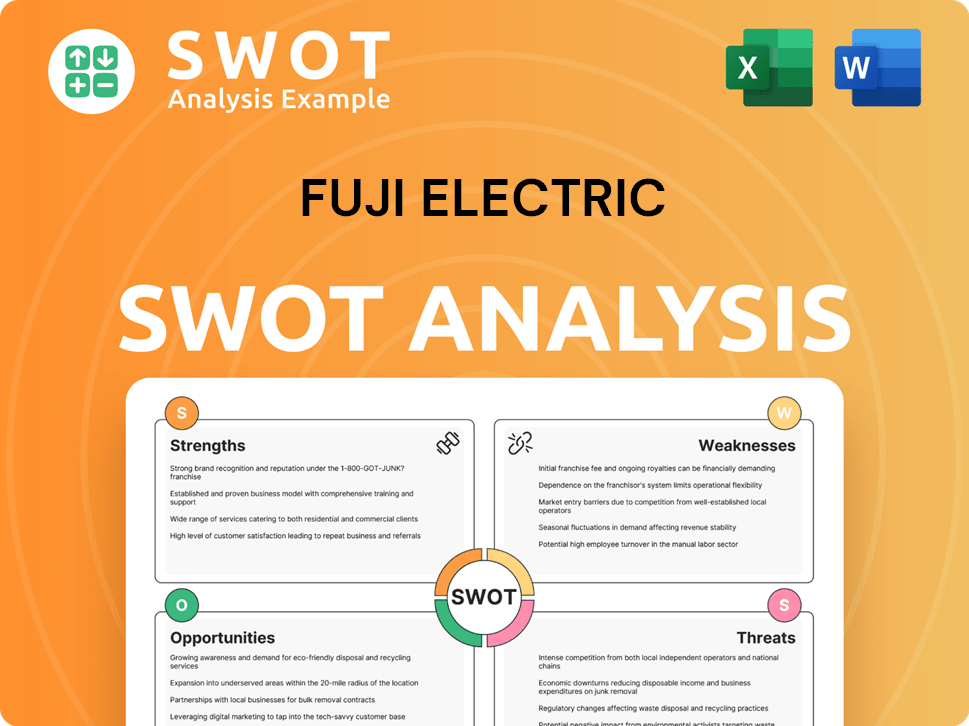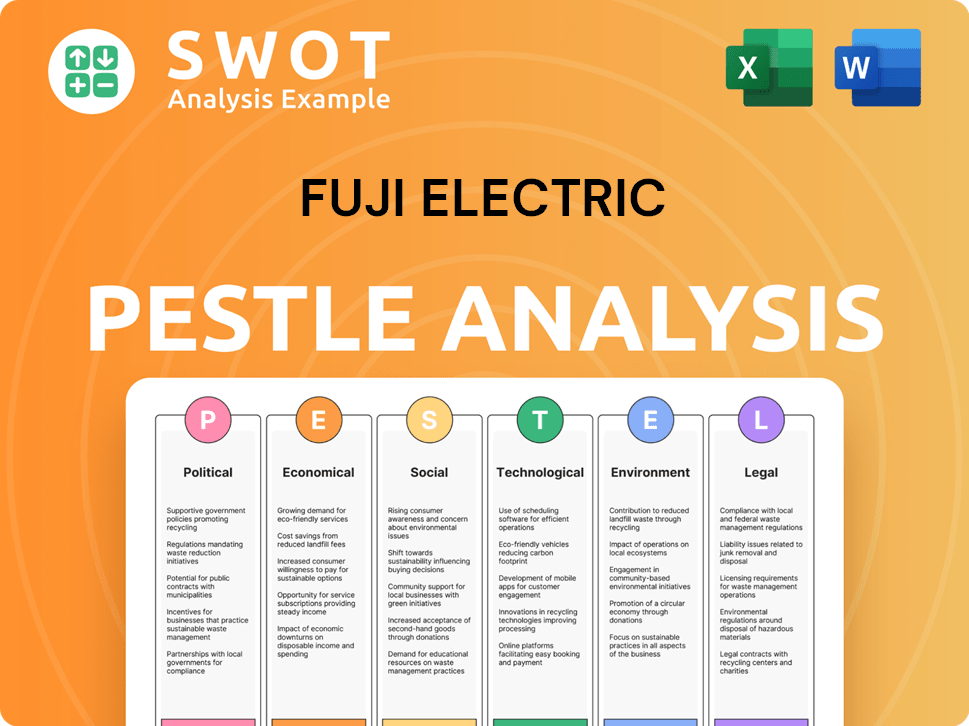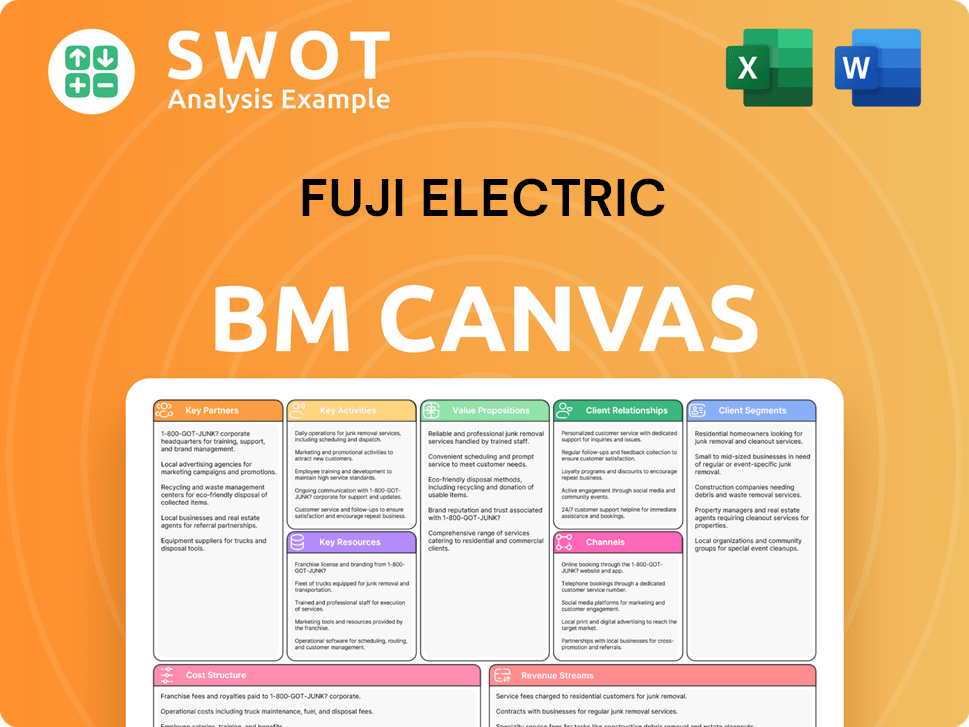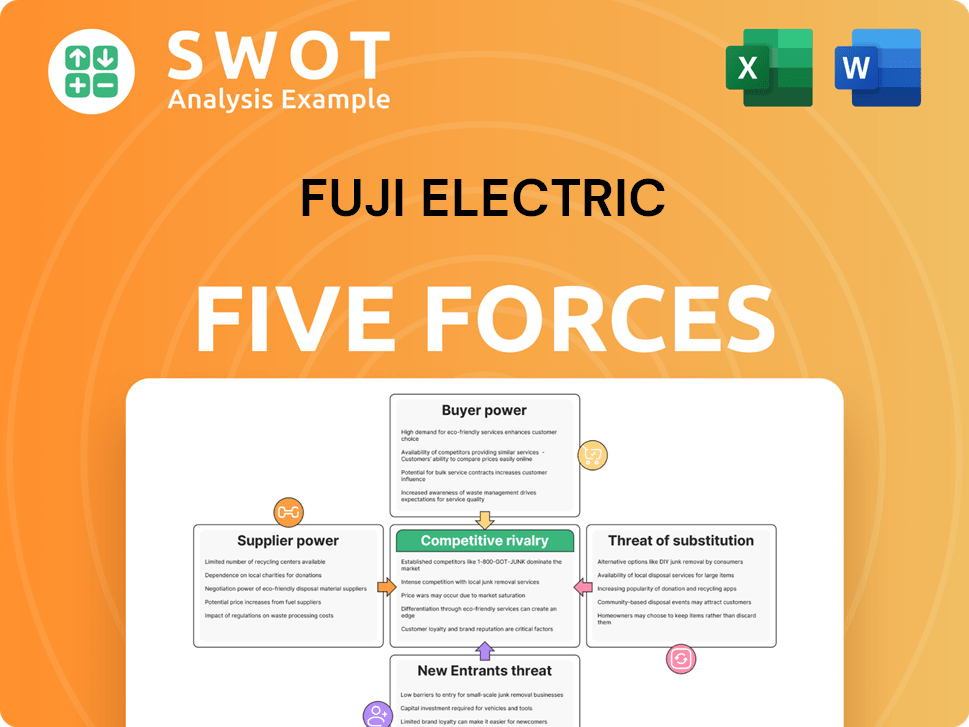Fuji Electric Bundle
Who Really Controls Fuji Electric?
Uncover the intricate web of influence behind a global powerhouse: Fuji Electric. Understanding the Fuji Electric SWOT Analysis is crucial, but who steers this industrial giant, and how does its ownership shape its future? From its origins as a joint venture to its current standing, the ownership structure of Fuji Electric company is a key factor in understanding its strategic direction.

Delving into the Fuji Electric ownership reveals a complex interplay of shareholders and stakeholders, each with a vested interest in the company's performance. Knowing the Fuji Electric parent company and major investors provides critical insights into its governance and strategic decisions. This exploration will uncover the evolution of Fuji Electric shareholders and the impact of these dynamics on its trajectory, offering a comprehensive view of this industry leader.
Who Founded Fuji Electric?
The genesis of Fuji Electric Company, initially named Fuji Denki Seizo K.K., occurred on August 29, 1923. This marked the beginning of a significant industrial venture in Japan, born from a strategic partnership. The founding of the company involved a collaboration between Furukawa Electric Co., Ltd. of Japan and Siemens AG of Germany.
This joint venture structure was designed to capitalize on German technological expertise in electrical machinery within the Japanese market. While the precise equity distribution between Furukawa Electric and Siemens at the outset isn't publicly available in specific percentages, the joint venture model indicates shared ownership and control.
Furukawa Electric's established presence in the Japanese market, combined with Siemens' technological prowess, set the stage for Fuji Electric's early focus on manufacturing electrical machinery and equipment. This collaboration was key in the company's initial product offerings.
The early ownership of Fuji Electric involved a joint venture between Furukawa Electric Co., Ltd. and Siemens AG. The partnership was centered on combining local market access with global technological capabilities. No significant early ownership disputes or buyouts have been widely reported, reflecting a stable initial collaboration. Further insights into the company's strategic direction can be found in Growth Strategy of Fuji Electric.
- The joint venture structure facilitated technology transfer from Siemens to Japan.
- Furukawa Electric provided market understanding and industrial presence.
- The early agreements likely focused on technology, market territories, and governance.
- No information is available on angel investors during this phase.
Fuji Electric SWOT Analysis
- Complete SWOT Breakdown
- Fully Customizable
- Editable in Excel & Word
- Professional Formatting
- Investor-Ready Format

How Has Fuji Electric’s Ownership Changed Over Time?
The evolution of Fuji Electric's ownership is a story of transformation, beginning in 1923 as a joint venture. Initially, it was a partnership between Furukawa Electric Co., Ltd. and Siemens AG. A pivotal moment came with its transition to a publicly traded company on the Tokyo Stock Exchange. This shift broadened the ownership base, moving beyond its founding corporate parents to include a variety of institutional and individual investors. This change marked a significant step in its corporate journey, influencing its strategic direction and financial structure.
As the company grew, its ownership structure adapted to the dynamics of the market. The shift to public trading allowed for greater access to capital and a more diverse shareholder base. This change has influenced the company's strategic direction, with major shareholders playing a key role in governance and long-term value creation. The company's history reflects its ability to adapt and evolve in response to changing market conditions and investor expectations, solidifying its position in the industry.
| Ownership Milestone | Details | Impact |
|---|---|---|
| 1923 | Established as a joint venture between Furukawa Electric Co., Ltd. and Siemens AG. | Initial structure laid the foundation for future growth and development. |
| Mid-20th Century | Transition to a publicly traded company. | Expanded ownership base and increased access to capital. |
| March 31, 2024 | Key shareholders include Furukawa Electric Co., Ltd., The Master Trust Bank of Japan, Ltd. (Trust Account), and Custody Bank of Japan, Ltd. (Trust Account). | Reflects a stable ownership base with a focus on long-term value creation. |
As of March 31, 2024, the major shareholders of the Fuji Electric Company include prominent Japanese financial institutions and corporate entities. Furukawa Electric Co., Ltd. remains a significant shareholder, reflecting its historical ties to the company. Other major stakeholders include leading Japanese banks and asset management firms. For example, The Master Trust Bank of Japan, Ltd. (Trust Account) and Custody Bank of Japan, Ltd. (Trust Account) are frequently listed among the top shareholders, indicating substantial holdings on behalf of various trust funds and institutional investors. Nippon Life Insurance Company and Toyota Motor Corporation are also notable shareholders. These institutional investors typically hold shares for long-term investment purposes, influencing company strategy through their voting power and engagement with management. The company's focus on sustainable development and energy efficiency aligns with the investment criteria of many large institutional funds. For more details, check out the Brief History of Fuji Electric.
Fuji Electric's ownership structure has evolved significantly since its inception, transitioning from a joint venture to a publicly traded company.
- Major shareholders include Japanese financial institutions and corporate entities.
- Furukawa Electric Co., Ltd. remains a significant shareholder.
- Institutional investors influence company strategy through voting and engagement.
- The ownership structure reflects a focus on long-term value creation.
Fuji Electric PESTLE Analysis
- Covers All 6 PESTLE Categories
- No Research Needed – Save Hours of Work
- Built by Experts, Trusted by Consultants
- Instant Download, Ready to Use
- 100% Editable, Fully Customizable

Who Sits on Fuji Electric’s Board?
The Board of Directors of Fuji Electric Co., Ltd. oversees the company's strategic direction and ensures accountability to shareholders. As of June 2024, the board includes a mix of internal directors, who are also executive officers, and independent outside directors. This structure aims to balance operational expertise with independent oversight. While specific board members representing major shareholders like Furukawa Electric or large institutional investors are not always explicitly named as direct representatives, the presence of these major shareholders naturally influences board appointments and strategic decisions. Understanding Fuji Electric ownership is key to grasping its governance.
The composition of the board reflects a commitment to both operational knowledge and independent oversight, which is a common practice among major Japanese corporations. The presence of independent directors is particularly important for ensuring objective decision-making and protecting the interests of all shareholders. This structure supports the company's long-term growth and adherence to its business objectives. Further insights into the Fuji Electric company can be found through examining its corporate governance reports.
| Director Type | Description | Role |
|---|---|---|
| Internal Directors | Executive officers of Fuji Electric | Oversee day-to-day operations and strategic implementation |
| Independent Outside Directors | Directors without prior executive roles in the company | Provide independent oversight and ensure accountability |
| Major Shareholders Influence | Representing entities like Furukawa Electric | Influence board appointments and strategic decisions |
The voting structure of Fuji Electric follows the standard principle of one-share-one-vote, common for publicly traded companies in Japan. Each ordinary share held by an investor carries one vote, ensuring that voting power is directly proportional to the number of shares owned. There are no indications of dual-class shares or special voting rights. This standard voting structure promotes a degree of democratic governance where all shareholders, regardless of size, have voting rights commensurate with their investment. This structure is crucial for understanding who owns Fuji Electric.
The board structure balances internal expertise with independent oversight, ensuring accountability. The one-share-one-vote system provides proportional voting power to all shareholders. For more on strategic approaches, consider the Marketing Strategy of Fuji Electric.
- Independent directors ensure objective decision-making.
- Voting power is directly proportional to share ownership.
- Governance focuses on long-term growth and shareholder interests.
- No recent proxy battles or significant governance controversies.
Fuji Electric Business Model Canvas
- Complete 9-Block Business Model Canvas
- Effortlessly Communicate Your Business Strategy
- Investor-Ready BMC Format
- 100% Editable and Customizable
- Clear and Structured Layout

What Recent Changes Have Shaped Fuji Electric’s Ownership Landscape?
Over the past three to five years, the ownership of the company has seen a steady evolution, reflecting broader industry trends in institutional investment and corporate governance. There have been no dramatic shifts like major acquisitions or hostile takeovers. The company continues to focus on its core business areas, which in turn influences investor interest. As of the fiscal year ending March 31, 2024, the company reported robust financial performance, with consolidated net sales increasing by 8.4% year-on-year to JPY 1,029.3 billion and operating income rising by 12.0% to JPY 86.6 billion. This strong performance can attract and solidify institutional ownership, as large funds often favor companies with stable growth and profitability. The Revenue Streams & Business Model of Fuji Electric is a key factor in understanding its ownership dynamics.
There have been no significant public announcements regarding large-scale share buybacks or secondary offerings that would drastically alter the ownership structure. The company’s focus remains on strategic investments in its core technologies, such as power semiconductors and factory automation, aligning with global trends in energy efficiency and industrial digitalization. This strategic direction is likely to maintain the interest of long-term institutional investors who prioritize sustainable growth and technological leadership. Industry trends indicate an increasing focus on ESG (Environmental, Social, and Governance) factors by institutional investors. The company's commitment to contributing to a sustainable society through its energy and environmental technologies aligns well with these trends, potentially attracting more ESG-focused funds.
The current ownership trend for the company appears to be one of stable institutional holding, driven by the company's consistent performance and alignment with key market trends. The company has not made any public statements about planned privatization or significant future ownership changes, suggesting a continued commitment to its public listing and current ownership model.
The company’s ownership is primarily characterized by institutional investors. These investors favor companies with stable growth and profitability. The company's strong financial performance, as of March 2024, has solidified institutional interest.
The company's focus on core technologies, such as power semiconductors and factory automation, attracts long-term investors. ESG factors are becoming increasingly important to investors. The company's commitment to sustainability is also a key factor.
The company is committed to its public listing and current ownership model. There are no current plans for privatization or significant ownership changes. The company is expected to maintain its current ownership structure.
The company’s robust financial performance, with increased sales and operating income, attracts investors. Strategic investments in core technologies contribute to sustainable growth. This performance helps solidify institutional ownership.
Fuji Electric Porter's Five Forces Analysis
- Covers All 5 Competitive Forces in Detail
- Structured for Consultants, Students, and Founders
- 100% Editable in Microsoft Word & Excel
- Instant Digital Download – Use Immediately
- Compatible with Mac & PC – Fully Unlocked

Related Blogs
- What are Mission Vision & Core Values of Fuji Electric Company?
- What is Competitive Landscape of Fuji Electric Company?
- What is Growth Strategy and Future Prospects of Fuji Electric Company?
- How Does Fuji Electric Company Work?
- What is Sales and Marketing Strategy of Fuji Electric Company?
- What is Brief History of Fuji Electric Company?
- What is Customer Demographics and Target Market of Fuji Electric Company?
Disclaimer
All information, articles, and product details provided on this website are for general informational and educational purposes only. We do not claim any ownership over, nor do we intend to infringe upon, any trademarks, copyrights, logos, brand names, or other intellectual property mentioned or depicted on this site. Such intellectual property remains the property of its respective owners, and any references here are made solely for identification or informational purposes, without implying any affiliation, endorsement, or partnership.
We make no representations or warranties, express or implied, regarding the accuracy, completeness, or suitability of any content or products presented. Nothing on this website should be construed as legal, tax, investment, financial, medical, or other professional advice. In addition, no part of this site—including articles or product references—constitutes a solicitation, recommendation, endorsement, advertisement, or offer to buy or sell any securities, franchises, or other financial instruments, particularly in jurisdictions where such activity would be unlawful.
All content is of a general nature and may not address the specific circumstances of any individual or entity. It is not a substitute for professional advice or services. Any actions you take based on the information provided here are strictly at your own risk. You accept full responsibility for any decisions or outcomes arising from your use of this website and agree to release us from any liability in connection with your use of, or reliance upon, the content or products found herein.